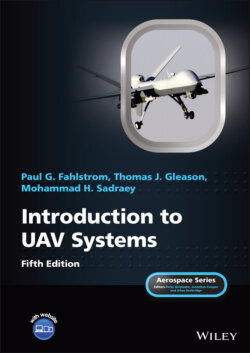Читать книгу Introduction to UAV Systems - Mohammad H. Sadraey - Страница 25
1.3 Overview of UAV Systems
ОглавлениеThe primary element of an unmanned aerial system is the air vehicle (AV). A number of titles are employed in the literature for the air vehicle, including: (1) unmanned aerial vehicle, (2) remotely piloted vehicles (RPV), (3) radio‐controlled (RC) plane, (4) model airplane, (5) remotely piloted aircraft (RPA), and (6) drones. The term RPV is an older name, and currently not much used. The term “RC plane” and “model airplane” are primarily used by hobbyists, aeromodellers, and Academy of Model Aeronautics (World’s largest model aviation association)1, and “drone” is mainly employed by the media.
All, of course, are unmanned so the name “unmanned aerial vehicle” or UAV can be thought of as the generic title. To the purist, the “remotely piloted vehicle” is piloted or steered (controlled) from a remotely located position, so an RPV is always a UAV, but a UAV, which may perform autonomous or preprogrammed missions, need not always be an RPV.
In the past, these aircraft were all called drones, that is, a “pilotless airplane controlled by radio signals,” according to Webster’s Dictionary. Today the UAV developer and user community do not use the term “drone” except for vehicles that have limited flexibility for accomplishing sophisticated missions and fly in a persistently dull, monotonous, and indifferent manner, such as a target drone. This has not prevented the press and the general public from adopting the word “drone” as a convenient, if technically incorrect, general term for UAVs. Thus, even the most sophisticated air vehicle with extensive semiautonomous functions is likely to be headlined as a “drone” in the morning paper or on the evening news.
Whether the UAV is controlled manually or via a preprogrammed navigation system, it should not necessarily be thought of as having to be “flown,” that is, controlled by someone that has piloting skills. UAVs used by the military usually have autopilots and navigation systems that maintain attitude, altitude, and ground track automatically.
Manual control usually means controlling the position of the UAV by manually adjusting the heading, altitude, speed, etc., through switches, a joystick, or some kind of pointing device (mouse or trackball) located in the ground control station, but allowing the autopilot to stabilize the vehicle and assume control when the desired course is reached. Navigation systems of various types (global positioning system (GPS), radio, inertial) allow for preprogrammed missions, which may or may not be overridden manually.
As a minimum, a typical UAV system is composed of air vehicles, one or more ground control stations (GCS) and/or mission planning and control stations (MPCS), payload, and data link. In addition, many systems include launch and recovery subsystems, air‐vehicle carriers, and other ground handling and maintenance equipment. A very simple generic UAV system is shown in Figure 1.1.
Figure 1.1 Generic UAV system
